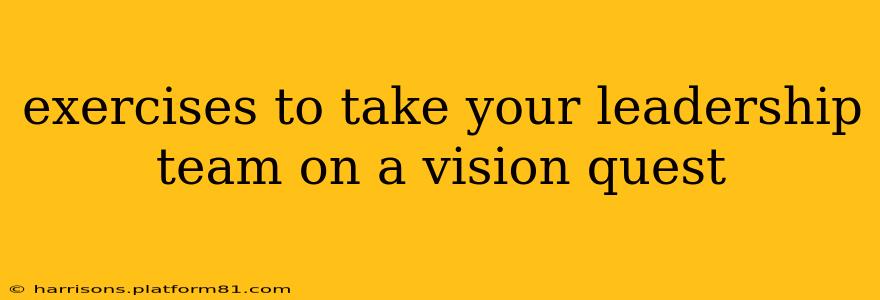Taking your leadership team on a vision quest isn't about a literal journey into the wilderness (though that could be a powerful experience!). It's about embarking on a shared journey of introspection, collaboration, and strategic planning to define a compelling future for your organization. This requires carefully designed exercises that foster creativity, collaboration, and a shared understanding of your collective vision.
This post outlines several exercises to guide your leadership team on this crucial quest. We’ll cover a range of approaches, catering to different team dynamics and preferences.
Why a Vision Quest for Your Leadership Team?
Before diving into specific exercises, let's understand why investing time in a vision quest for your leadership team is critical. A shared vision acts as a North Star, guiding decision-making, fostering alignment, and motivating the entire organization. When your leadership team is unified in its vision, it ripples down, creating a stronger, more effective, and more engaged workforce.
Exercises to Ignite Your Leadership Team's Vision
Here are several exercises designed to help your leadership team embark on a powerful vision quest:
1. The Future Timeline Exercise
What it is: This exercise helps your team visualize the future by collaboratively creating a timeline of key milestones and achievements over a set period (e.g., 5, 10, or 20 years).
How to do it:
- Brainstorm: Start by brainstorming all potential achievements and milestones. Encourage wild ideas initially.
- Timeline creation: Use a whiteboard or digital tool to create a visual timeline, placing milestones in chronological order.
- Discussion: Discuss the significance of each milestone, the challenges involved, and the resources needed.
- Prioritization: Once the timeline is complete, prioritize the most crucial milestones.
Benefits: This exercise fosters a shared understanding of the long-term goals and provides a roadmap for the future.
2. The "Ideal Future State" Scenario Planning
What it is: This exercise challenges your leadership team to paint a picture of the organization's ideal future state – the ultimate success story.
How to do it:
- Individual Reflection: Each team member individually spends time reflecting and writing down their vision of the ideal future.
- Group Sharing: In a facilitated session, each member shares their vision. Focus on capturing the essence, not the details.
- Identifying Common Threads: The facilitator helps the group identify common themes, values, and aspirations that emerge from the individual visions.
- Collaborative Refinement: The team collaboratively refines the collective vision, creating a clear, concise, and inspiring statement.
Benefits: This exercise encourages individual contributions while building a cohesive and inspiring shared vision.
3. The "Appreciative Inquiry" Approach
What it is: This positive psychology-based approach focuses on identifying and building upon the organization's strengths and successes to create a compelling future vision.
How to do it:
- Discovery: The team explores past successes and positive experiences, identifying what worked well and why.
- Dreaming: Based on the discoveries, the team dreams about future possibilities and aspirations.
- Design: The team designs strategies and action plans to achieve their envisioned future.
- Destiny: The team commits to taking action and monitors progress toward their vision.
Benefits: This approach builds on existing positive momentum and fosters a positive and collaborative environment.
4. The "Strengths, Weaknesses, Opportunities, Threats" (SWOT) Analysis with a Future Focus
What it is: A classic strategic planning tool adapted for vision-setting.
How to do it:
- Future Perspective: Instead of focusing solely on the present, the team projects the organization's strengths, weaknesses, opportunities, and threats into the future.
- Collaborative Brainstorming: The team collaborates in brainstorming sessions to identify potential future SWOT elements.
- Strategic Alignment: The team leverages this analysis to align its vision with the organization's strengths, mitigate weaknesses, capitalize on opportunities, and address potential threats.
Benefits: This provides a structured approach to aligning the vision with practical considerations.
5. The "Vision Board" Exercise (Creative Approach)
What it is: A visual exercise that uses images, words, and symbols to represent the team’s shared vision.
How to do it:
- Gather Materials: Collect magazines, pictures, and other visual materials.
- Individual Creation: Each team member creates a personal vision board.
- Group Sharing and Collaboration: Team members share their boards, explaining their choices. A collective vision board can then be created.
Benefits: This fosters creativity and allows for a more intuitive and less verbal approach to vision development.
Post-Vision Quest Steps
Following these exercises, it's crucial to:
- Document the Vision: Create a clear, concise, and inspiring written statement of your shared vision.
- Communicate the Vision: Share the vision with the entire organization, ensuring everyone understands and embraces it.
- Develop an Action Plan: Outline specific steps and strategies to achieve the vision.
- Regularly Review and Refine: The vision should be a living document, regularly reviewed and refined as needed.
By using these exercises, your leadership team can embark on a transformative vision quest, creating a shared roadmap for a successful and fulfilling future. Remember to choose exercises that best suit your team's style and dynamics. The key is to create a collaborative, engaging, and inspiring experience that leads to a unified and compelling vision.
